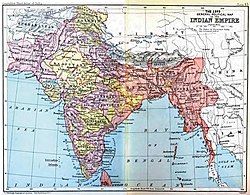Casa da India

Ribeira Palace, where the house was located
|
|
| Industry | International trade |
|---|---|
| Fate | Dissolved |
| Predecessor | Company of Guinea |
| Founded | 1434 |
| Defunct | September 17, 1833 |
| Headquarters | Lisbon, Kingdom of Portugal |
|
Area served
|
Portuguese Empire |
|
Key people
|
Manuel I of Portugal |

Imperial entities of India
|
|
| Dutch India | 1605–1825 |
|---|---|
| Danish India | 1620–1869 |
| French India | 1769–1954 |
|
|
|
| Casa da Índia | 1434–1833 |
| Portuguese East India Company | 1628–1633 |
|
|
|
| East India Company | 1612–1757 |
| Company rule in India | 1757–1858 |
| British Raj | 1858–1947 |
| British rule in Burma | 1824–1948 |
| Princely states | 1721–1949 |
| Partition of India |
1947
|
|
|
|
Casa da Índia (Portuguese pronunciation: [ˈkazɐ dɐ ˈĩdiɐ], India House) was the Portuguese organization that managed all overseas territories during the heyday of the Portuguese Empire in the 16th century. It was both the central authority for managing all aspects of overseas trade, the central shipment point and clearing house. As an economic institution, it worked like a feitoria (factory, trading post), being the most important economic institution in Portugal of the time. It was located at the Ribeira Palace, the royal palace in Terreiro do Paço square (modern Praça do Comércio), in Lisbon.
The forerunners of Casa da Índia arose with the Portuguese exploration of the African coast, to manage new trade opportunities.
As early as 1434 the Casa de Ceuta was founded in Lisbon, but it was not very successful because the Muslim merchants diverted the trade routes from Ceuta to other places. Around 1443 in Lagos, Algarve, the Casa de Arguim and Casa da Guiné, were established to administer Prince Henry the Navigator's monopoly on African trade - essentially a set of sheds, warehouses and customs offices, dedicated to outfitting ships, hiring captains and crews, handing out trading licenses, receiving and selling goods and collecting dues. After the death of Henry the Navigator in 1460, both houses were moved by King Afonso V of Portugal from Lagos to Lisbon.
The ascension of King John II of Portugal in 1481 revived the royal interest in African trade. In 1482, upon erecting the fortress of São Jorge da Mina to access the Akan goldfields and markets, John II overhauled the old houses and organized the system into two new institutions in Lisbon - the royal trading house, the Casa da Mina e Tratos de Guiné, focused on commercial aspects of African trade (goods, licenses, dues), and the separate royal naval arsenal, the Armazém da Guiné, to handle nautical matters (ship construction, nautical supplies, hiring of crews, etc.) In 1486, after the opening of contact with Benin, John II established the Casa de Escravos, as a distinct slave-trading department of the Casa da Mina.
...
Wikipedia
